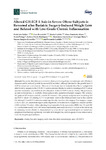Mostrar o rexistro simple do ítem
Altered GH-IGF-1 axis in severe obese subjects is reversed after bariatric surgery-induced weight loss and related with low-grade chronic inflammation
| dc.contributor.author | Juiz-Valiña, Paula | |
| dc.contributor.author | Pena-Bello, Lara | |
| dc.contributor.author | Cordido, María | |
| dc.contributor.author | Outeiriño-Blanco, Elena | |
| dc.contributor.author | Pértega-Díaz, Sonia | |
| dc.contributor.author | Varela-Rodríguez, Bárbara María | |
| dc.contributor.author | García-Brao, María Jesús | |
| dc.contributor.author | Mena, Enrique | |
| dc.contributor.author | Sangiao-Alvarellos, Susana | |
| dc.contributor.author | Cordido, Fernando | |
| dc.date.accessioned | 2020-10-05T12:33:24Z | |
| dc.date.available | 2020-10-05T12:33:24Z | |
| dc.date.issued | 2020-08-12 | |
| dc.identifier.citation | Juiz-Valiña P, Pena-Bello L, Cordido M, Outeiriño-Blanco E, Pértega S, Varela-Rodriguez B, Garcia-Brao MJ, Mena E, Sangiao-Alvarellos S, Cordido F. Altered GH-IGF-1 axis in severe obese subjects is reversed after bariatric surgery-induced weight loss and related with low-grade chronic inflammation. J Clin Med. 2020 Aug 12;9(8):2614. | es_ES |
| dc.identifier.issn | 2077-0383 | |
| dc.identifier.uri | http://hdl.handle.net/2183/26337 | |
| dc.description.abstract | [Abstract] Endocrine disorders are common in obesity, including altered somatotropic axis. Obesity is characterized by reduced growth hormone (GH) secretion, although the insulin-like growth factor-1 (IGF-1) values are controversial. The aim of this study was to evaluate the effect of weight loss after bariatric surgery in the GH–IGF-1 axis in extreme obesity, in order to investigate IGF-1 values and the mechanism responsible for the alteration of the GH–IGF-1 axis in obesity. We performed an interventional trial in morbidly obese patients who underwent bariatric surgery. We included 116 patients (97 women) and 41 controls (30 women). The primary endpoint was circulating GH and IGF-1 values. Circulating IGF-1 values were lower in the obese patients than in the controls. Circulating GH and IGF-1 values increased significantly over time after surgery. Post-surgery changes in IGF-1 and GH values were significantly negatively correlated with changes in C-reactive protein (CRP) and free T4 values. After adjusting for preoperative body mass index (BMI), free T4 and CRP in a multivariate model, only CRP was independently associated with IGF-1 values in the follow-up. In summary, severe obesity is characterized by a functional hyposomatotropism at central and peripheral level that is progressively reversible with weight loss, and low-grade chronic inflammation could be the principal mediator. | es_ES |
| dc.description.sponsorship | The results of this work have been funded by the Projects Nº PI13/00322 to F.C. and PI16/00884 to F.C. and S.S-A.; integrated in the National Plan for Scientific Research, Development and Technological Innovation 2013–2016 and funded by the ISCIII (Instituto de Salud Carlos III)-General Subdirection of Assessment and Promotion of the Research–European Regional Development Fund (FEDER) “A way of making Europe”. | es_ES |
| dc.description.sponsorship | info:eu-repo/grantAgreement/MINECO/Programa Estatal de I+D+I Orientada a los Retos de la Sociedad/PI13%2F00322/ES/EVOLUCION DE LAS HORMONAS GASTROINTESTINALES TRAS LA DISMINUCION DE LA ADIPOSIDAD Y LA MODIFICACIÓN DE LOS NIVELES DE GH. EL EJE CEREBRO-INTESTINO | es_ES |
| dc.description.sponsorship | info:eu-repo/grantAgreement/MINECO/Programa Estatal de I+D+I Orientada a los Retos de la Sociedad/PI16%2F00884/ES/RELACION ENTRE MARCADORES HORMONALES DE CONTROL DE LA INGESTA Y GASTO METABÓLICO. EFECTO DEL BALANCE ENERGÉTICO NEGATIVO Y LA MODIFICACIÓN DE GH | |
| dc.language.iso | eng | es_ES |
| dc.publisher | MDPI | es_ES |
| dc.relation.uri | ttps://doi.org/10.3390/jcm9082614 | es_ES |
| dc.rights | Creative Commons Attribution 4.0 International License (CC-BY 4.0) | es_ES |
| dc.rights.uri | http://creativecommons.org/licenses/by/4.0/ | * |
| dc.subject | Obesity | es_ES |
| dc.subject | Bariatric surgery | es_ES |
| dc.subject | Endocrine disorders | es_ES |
| dc.subject | Somatotropic axis | es_ES |
| dc.subject | GH | es_ES |
| dc.subject | IGF-1 | es_ES |
| dc.title | Altered GH-IGF-1 axis in severe obese subjects is reversed after bariatric surgery-induced weight loss and related with low-grade chronic inflammation | es_ES |
| dc.type | info:eu-repo/semantics/article | es_ES |
| dc.rights.access | info:eu-repo/semantics/openAccess | es_ES |
| UDC.journalTitle | Journal of Clinical Medicine | es_ES |
| UDC.volume | 9 | es_ES |
| UDC.issue | 8 | es_ES |
| UDC.startPage | 2614 | es_ES |
Ficheiros no ítem
Este ítem aparece na(s) seguinte(s) colección(s)
-
GI-FENM - Artigos [119]






